Denon S-81 User Manual

PERSONAL AUDIO SYSTEM
S-81
OPERATING INSTRUCTIONS
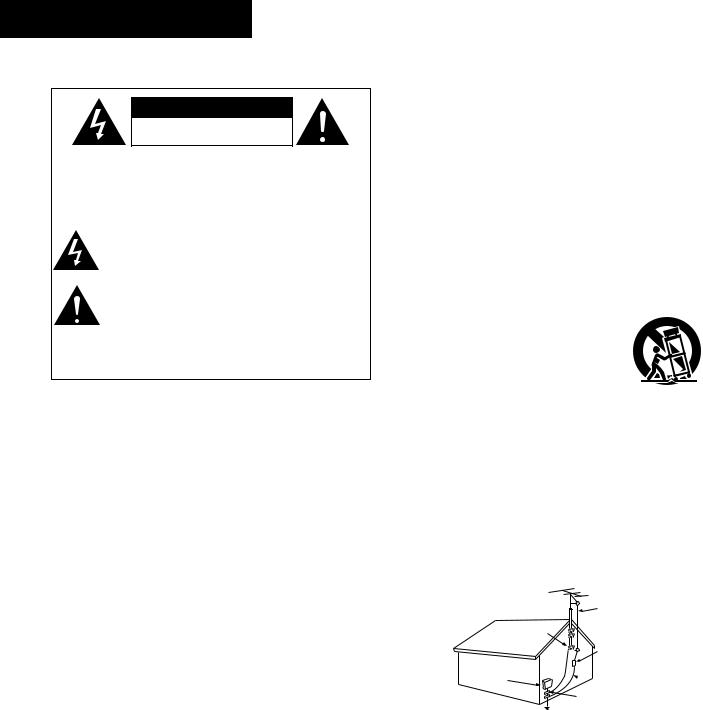
ENGLISH
2 SAFETY PRECAUTIONS
CAUTION
RISK OF ELECTRIC SHOCK
DO NOT OPEN
CAUTION:
TO REDUCE THE RISK OF ELECTRIC SHOCK, DO NOT REMOVE COVER (OR BACK). NO USER-SERVICEABLE PARTS INSIDE. REFER SERVICING TO QUALIFIED SERVICE PERSONNEL.
The lightning flash with arrowhead symbol, within an equilateral triangle, is intended to alert the user to the presence of uninsulated “dangerous voltage” within the product’s enclosure that may be of sufficient magnitude to constitute a risk of electric shock t persons.
The exclamation point within an equilateral triangle is intended to alert the user to the presence of important operating and maintenance (servicing) instructions in the literature accompanying the appliance.
WARNING:
TO REDUCE THE RISK OF FIRE OR ELECTRIC SHOCK, DO NOT EXPOSE THIS APPLIANCE TO RAIN OR MOISTURE.
CAUTION:
USE OF CONTROLS OR ADJUSTMENTS OR PERFORMANCE OF PROCEDURES OTHER THAN THOSE SPECIFIED HEREIN MAY RESULT IN HAZARDOUS RADIATION EXPOSURE.
THIS PRODUCT SHOULD NOT BE ADJUSTED OR REPAIRED BY ANYONE EXCEPT PROPERLY QUALIFIED SERVICE PERSONNEL.
SAFETY INSTRUCTIONS
1.Read Instructions – All the safety and operating instructions should be read before the product is operated.
2.Retain Instructions – The safety and operating instructions should be retained for future reference.
3.Heed Warnings – All warnings on the product and in the operating instructions should be adhered to.
4.Follow Instructions – All operating and use instructions should be followed.
5.Cleaning – Unplug this product from the wall outlet before cleaning. Do not use liquid cleaners or aerosol cleaners.
6.Attachments – Do not use attachments not recommended by the product manufacturer as they may cause hazards.
7.Water and Moisture – Do not use this product near water – for example, near a bath tub, wash bowl, kitchen sink, or laundry tub; in a wet basement; or near a swimming pool; and the like.
8.Accessories – Do not place this product on an unstable cart, stand, tripod, bracket, or table. The product may fall, causing serious injury to a child or adult, and serious damage to the product. Use only with a cart, stand,
tripod, bracket, or table recommended by the manufacturer, or sold with the product. Any
mounting of the product should follow the manufacturer’s instructions, and should use a
mounting accessory recommended by the manufacturer.
9. A product and cart combination should be moved with care. Quick stops, excessive force, and uneven surfaces may cause the product and cart combination to overturn.
10.Ventilation – Slots and openings in the cabinet are provided for ventilation and to ensure reliable operation of the product and to protect it from overheating, and these openings must not be blocked or covered. The openings should never be blocked by placing the product on a bed, sofa, rug, or other similar surface. This product should not be placed in a built-in installation such as a bookcase or rack unless proper ventilation is provided or the manufacturer’s instructions have been adhered to.
11.Power Sources – This product should be operated only from the type of power source indicated on the marking label. If you are not sure of the type of power supply to your home, consult your product dealer or local power company. For products intended to operate from battery power, or other sources, refer to the operating instructions.
12.Grounding or Polarization – This product may be equipped with a polarized alternating-current line plug (a plug having one blade wider than the other). This plug will fit into the power outlet only one way. This is a safety feature. If you are unable to insert the plug fully into the outlet, try reversing the plug. If the plug should still fail to fit, contact your electrician to replace your obsolete outlet. Do not defeat the safety purpose of the polarized plug.
FIGURE A
EXAMPLE OF ANTENNA GROUNDING
AS PER NATIONAL
ELECTRICAL CODE
GROUND
CLAMP
ANTENNA
LEAD IN
WIRE
ANTENNA DISCHARGE UNIT (NEC SECTION 810-20)
ELECTRIC
SERVICE
EQUIPMENT

 GROUNDING CONDUCTORS (NEC SECTION 810-21)
GROUNDING CONDUCTORS (NEC SECTION 810-21)
 GROUND CLAMPS
GROUND CLAMPS
 POWER SERVICE GROUNDING
POWER SERVICE GROUNDING
ELECTRODE SYSTEM NEC - NATIONAL ELECTRICAL CODE (NEC ART 250, PART H)
13.Power-Cord Protection – Power-supply cords should be routed so that they are not likely to be walked on or pinched by items placed upon or against them, paying particular attention to cords at plugs, convenience receptacles, and the point where they exit from the product.
15.Outdoor Antenna Grounding – If an outside antenna or cable system is connected to the product, be sure the antenna or cable system is grounded so as to provide some protection against voltage surges and built-up static charges. Article 810 of the National Electrical Code, ANSI/NFPA 70, provides information with regard to proper grounding of the mast and supporting structure, grounding of the lead-in wire to an antenna discharge unit, size of grounding conductors, location of antenna-discharge unit, connection to grounding electrodes, and requirements for the grounding electrode. See Figure A.
16.Lightning – For added protection for this product during a lightning storm, or when it is left unattended and unused for long periods of time, unplug it from the wall outlet and disconnect the antenna or cable system. This will prevent damage to the product due to lightning and power-line surges.
17.Power Lines – An outside antenna system should not be located in the vicinity of overhead power lines or other electric light or power circuits, or where it can fall into such power lines or circuits. When installing an outside antenna system, extreme care should be taken to keep from touching such power lines or circuits as contact with them might be fatal.
18.Overloading – Do not overload wall outlets, extension cords, or integral convenience receptacles as this can result in a risk of fire or electric shock.
19.Object and Liquid Entry – Never push objects of any kind into this product through openings as they may touch dangerous voltage points or short-out parts that could result in a fire or electric shock. Never spill liquid of any kind on the product.
20.Servicing – Do not attempt to service this product yourself as opening or removing covers may expose you to dangerous voltage or other hazards. Refer all servicing to qualified service personnel.
21.Damage Requiring Service – Unplug this product from the wall outlet and refer servicing to qualified service personnel under the following conditions:
a)When the power-supply cord or plug is damaged,
b)If liquid has been spilled, or objects have fallen into the product,
c)If the product has been exposed to rain or water,
d)If the product does not operate normally by following the operating instructions. Adjust only those controls that are covered by the operating instructions as an improper adjustment of other controls may result in damage and will often require extensive work by a qualified technician to restore the product to its normal operation,
e)If the product has been dropped or damaged in any way, and
f)When the product exhibits a distinct change in performance – this indicates a need for service.
22.Replacement Parts – When replacement parts are required, be sure the service technician has used replacement parts specified by the manufacturer or have the same characteristics as the original part. Unauthorized substitutions may result in fire, electric shock, or other hazards.
23.Safety Check – Upon completion of any service or repairs to this product, ask the service technician to perform safety checks to determine that the product is in proper operating condition.
24.Wall or Ceiling Mounting – The product should be mounted to a wall or ceiling only as recommended by the manufacturer.
25.Heat – The product should be situated away from heat sources such as radiators, heat registers, stoves, or other products (including amplifiers) that produce heat.
I

ENGLISH
FCC INFORMATION (For US customers)
1. PRODUCT
This product complies with Part 15 of the FCC Rules. Operation is subject to the following two conditions: (1) this product may not cause harmful interference, and (2) this product must accept any interference received, including interference that may cause undesired operation.
2.IMPORTANT NOTICE: DO NOT MODIFY THIS PRODUCT
This product, when installed as indicated in the instructions contained in this manual, meets FCC requirements. Modification not expressly approved by DENON may void your authority, granted by the FCC, to use the product.
3.NOTE
This product has been tested and found to comply with the limits for a Class B digital device, pursuant to Part 15 of the FCC Rules. These limits are designed to provide reasonable protection against harmful interference in a residential installation.
This product generates, uses and can radiate radio frequency energy and, if not installed and used in accordance with the instructions, may cause harmful interference to radio communications. However, there is no guarantee that interference will not occur in a particular installation. If this product does cause harmful interference to radio or television reception, which can be determined by turning the product OFF and ON, the user is encouraged to try to correct the interference by one or more of the following measures:
•Reorient or relocate the receiving antenna.
•Increase the separation between the equipment and receiver.
•Connect the product into an outlet on a circuit different from that to which the receiver is connected.
•Consult the local retailer authorized to distribute this type of product or an experienced radio/TV technician for help.
This class B digital apparatus complies with Canadian ICES-003.
Cet appareil numérique de la classe B est conforme à la norme NMB-003 du
Canada.
II
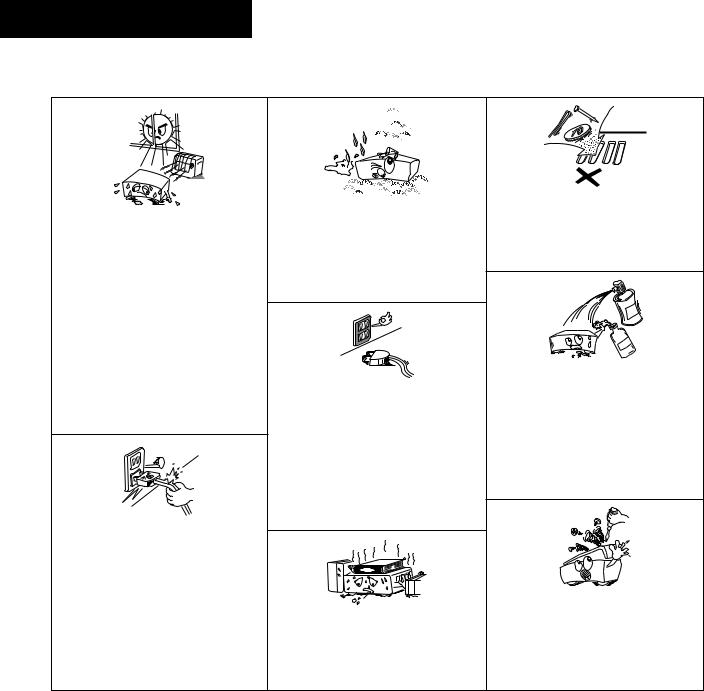
ENGLISH
2 NOTE ON USE
• Do not let foreign objects into the apparatus.
• Keep the apparatus free from moisture, water, and dust.
• Avoid high temperatures.
Allow for sufficient heat dispersion when installed in a rack.
•Unplug the power cord when not using the apparatus for long periods of time.
•Do not let insecticides, benzene, and thinner come in contact with the apparatus.
• Handle the power cord carefully.
Hold the plug when unplugging the cord.
* (For apparatuses with ventilation holes)
• Never disassemble or modify the apparatus in any way.
• Do not obstruct the ventilation holes.
III
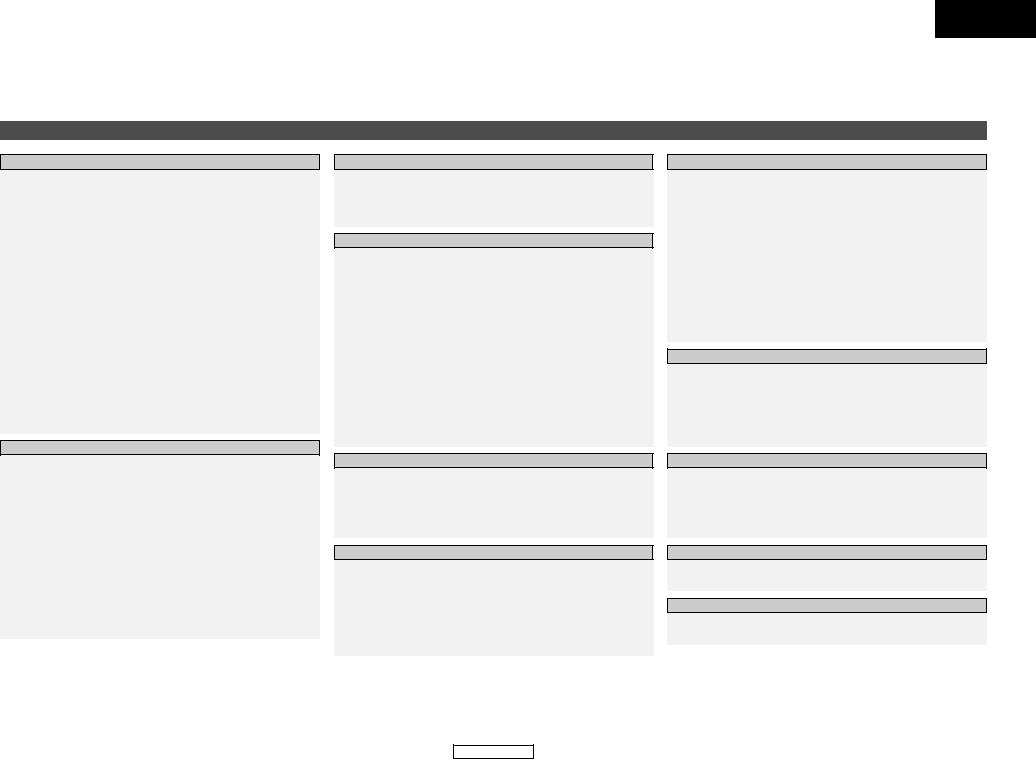
ENGLISH
Thank you for purchasing this DENON Personal Audio System.
Please read the operation instructions thoroughly in order to acquaint yourself with the Personal Audio System and achieve maximum satisfaction from it.
Contents
Getting Started
Accessories······················································································2
Before using ····················································································2
Cautions on installation ·································································2
Speaker system (SC-S81)·······························································3
About discs
Discs usable on this set ·································································3
Holding discs··················································································3 Loading discs ·················································································3
Cautions on loading discs ······························································3
Cautions on handling······································································4 Cautions on storing discs·······························································4 Cleaning discs ················································································4
About the remote control unit
Inserting the batteries ····································································4
Operating range of the remote control unit ···································4
Part names and functions
Front panel ·····················································································5
Display····························································································5 Rear panel ······················································································6
Remote control unit ···································································6, 7
Connections
Cable indications ············································································7
Speaker connections ······································································8
Changing the speaker cable···························································8
Antenna connections
Connecting the included antennas·················································9 Connecting an outdoor antenna·····················································9 Connecting the XM terminal ·······················································10
Connecting a portable player ······················································10
Connecting to an iPod®
When using the included iPod cable············································10 When using an exclusive control Dock for iPod ··························11
When using an Apple iPod Dock ·················································11
Connecting a CD recorder····························································12
Connecting the power supply cord ············································12
Basic Operation
Turning the power on···································································13
Loading discs ················································································13
Adjusting the volume···································································13
Adjusting the tone········································································13
Listening to radio broadcasts
Selecting a radio station······························································14
Giving a name to the currently tuned in
broadcast station and presetting it ············································14
Presetting broadcast stations automatically (Auto preset) ·····15
Listening to preset broadcast stations·······································15
RDS (Radio Data System) ····························································15
RDS search ··················································································16
PTY search ···················································································16
TP search ·····················································································16
RT (Radio Text) ·············································································16
XM Satellite Radio········································································16
Checking the XM signal strength and Radio ID ···························17
Channel selection·········································································17 Category search ···········································································17
Direct access of channels ····························································17
Using the timer function
Setting the current time ······························································18
Before setting the timer·······························································18
Setting the everyday or once timer············································19
Operation of the everyday and once timers ······························20
Setting the sleep timer ································································20
Using other functions
Setting the low-power standby mode
Setting the time display time in the standby mode·····················21 Setting the low-power standby mode (Eco mode) ······················21
Making the speaker settings
Setting the speakers low bass sound··········································21 Setting the speaker locations·······················································21 Making the room damping setting···············································21
Playing discs
Starting playback··········································································22
To stop playback···········································································22 To pause playback (Pause) ···························································22
Fast-forwarding (Search) ······························································22
Fast-reversing (Search)·································································22 Moving to the beginning of tracks (Skip) ·····································22
Playing the desired track (Direct play) ·······································23
Listening to specific tracks in a specific order
(Programmed play)·······································································23
Listening in random order (Random playback)·························23
Listening to tracks repeatedly (Repeat play)
Listening to a specific track repeatedly (1-track repeat play)·······23 Listening to all the tracks repeatedly (All-track repeat play) ········23
Playing MP3 or WMA (Windows Media® Audio) files
Before playing MP3 or WMA files···············································24
Playing MP3 or WMA files ···························································25
Listening to MP3 or WMA files in random order
(Random folder/disc play) ···························································25
Listening to MP3 or WMA files repeatedly
(Repeat folder/disc play)······························································26
Other types of playback
Playing an iPod® ··········································································27
Using the included iPod cable······················································27 Using an exclusive control Dock for iPod ····································27
Using an Apple iPod Dock····························································27 Playing a portable player ·····························································27
System Operations
Auto power on function·······························································27
Auto function selection································································27
Others
Troubleshooting······································································28, 29
Specifications ················································································30
1
ENGLISH
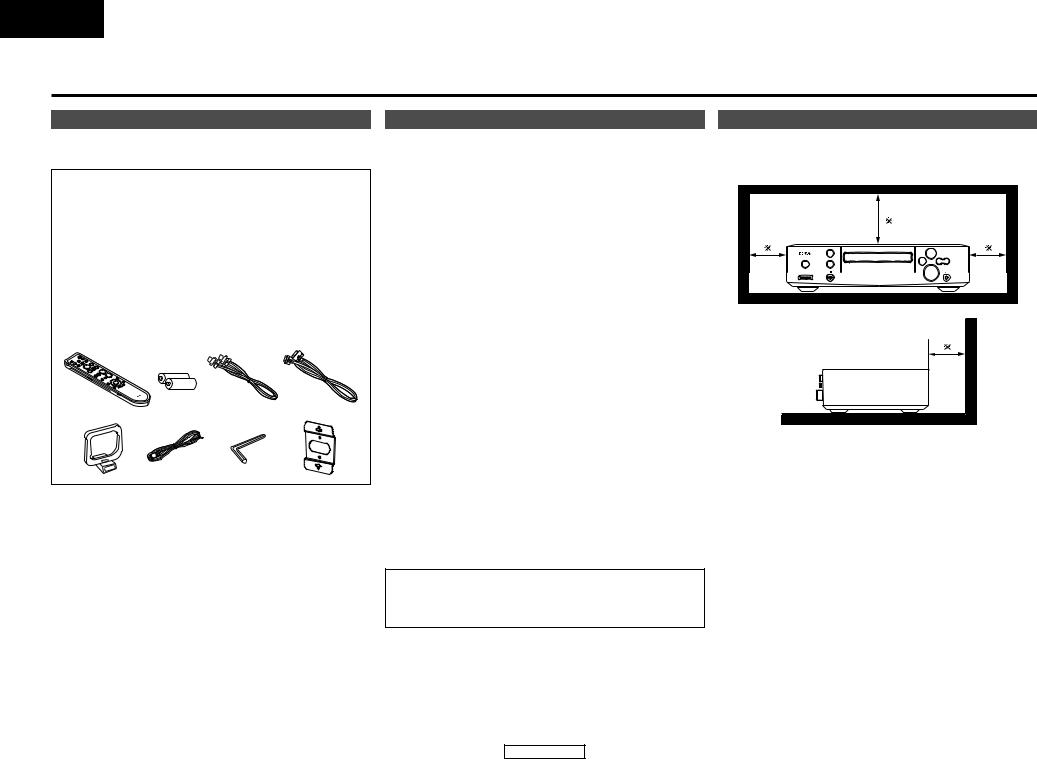
ENGLISH
Getting Started
Accessories
Check that the following parts are attached in addition to the main unit:
q Operating instructions ............................................................. |
|
1 |
|
w Warranty (for North America model only ) |
...............................1 |
||
e Service station list.................................................................... |
|
|
1 |
r Screw....................................................................................... |
|
|
4 |
t Remote control unit (RC-1035) ................................................ |
|
1 |
|
y R6P/AA batteries ..................................................................... |
|
|
2 |
u Speaker cable (Approx. 16 ft / 5 m) ......................................... |
|
2 |
|
i iPod cable (Approx. 3 ft / 1 m) ................................................. |
|
1 |
|
o AM loop antenna ..................................................................... |
|
|
1 |
!0FM indoor antenna................................................................... |
|
|
1 |
!1Hexagonal wrench ................................................................... |
|
|
1 |
!2Wall bracket ............................................................................. |
|
|
2 |
t |
y |
u |
i |
o |
!0 |
!1 |
!2 |
Before using |
Cautions on installation |
|
Pay attention to the following before using this unit: |
Note: |
|
• Moving the unit. |
For heat dispersal, do not install this unit in a confined space |
|
such as a bookcase or similar enclosure. |
||
To prevent short-circuits or damaged wires in the connection cables, |
||
|
||
always unplug the power supply cord and disconnect the connection |
|
|
cables between all other audio components when moving the unit. |
|
|
• Cautions on using mobile phones. |
Note |
|
Using a mobile phone near this unit may result in noise. If so, move |
||
|
||
the mobile phone away from this unit when it is in use. |
|
|
• Condensation (dew). |
|
|
Water droplets may condense on internal operation parts if the set |
|
|
is brought into a heated room from the cold outdoors or when the |
|
|
room is heated rapidly. If this happens, the set may not operate |
|
|
properly. |
|
|
• Should condensation occur. |
|
|
The condensation will evaporate in one hour or less, at which time |
|
|
the system will function normally. |
|
|
• Before turning the power operation switch on. |
Wall |
|
|
||
Check once again that all connections are correct and that there are |
|
|
not problems with the connection cables. Always set the power |
|
|
operation switch to the standby position before connecting and |
|
|
disconnecting connection cables. |
|
•Store these instructions in a safe place.
After reading, store this instructions along with the warranty card in a safe place.
•Power is supplied to some of the circuitry even when the power is set to the standby mode using the power operation switch. When traveling or leaving home for long periods of time, be sure to unplug the power supply cord from the power outlet.
•Note that the illustrations in these instructions may differ from the actual unit for explanation purposes.
NOTE:
•This personal audio system uses a semiconductor laser. To ensure stable operation, it is recommended to use the set indoors at a temperature of 5°C (41°F) ~ 35°C (95°F).
2
ENGLISH
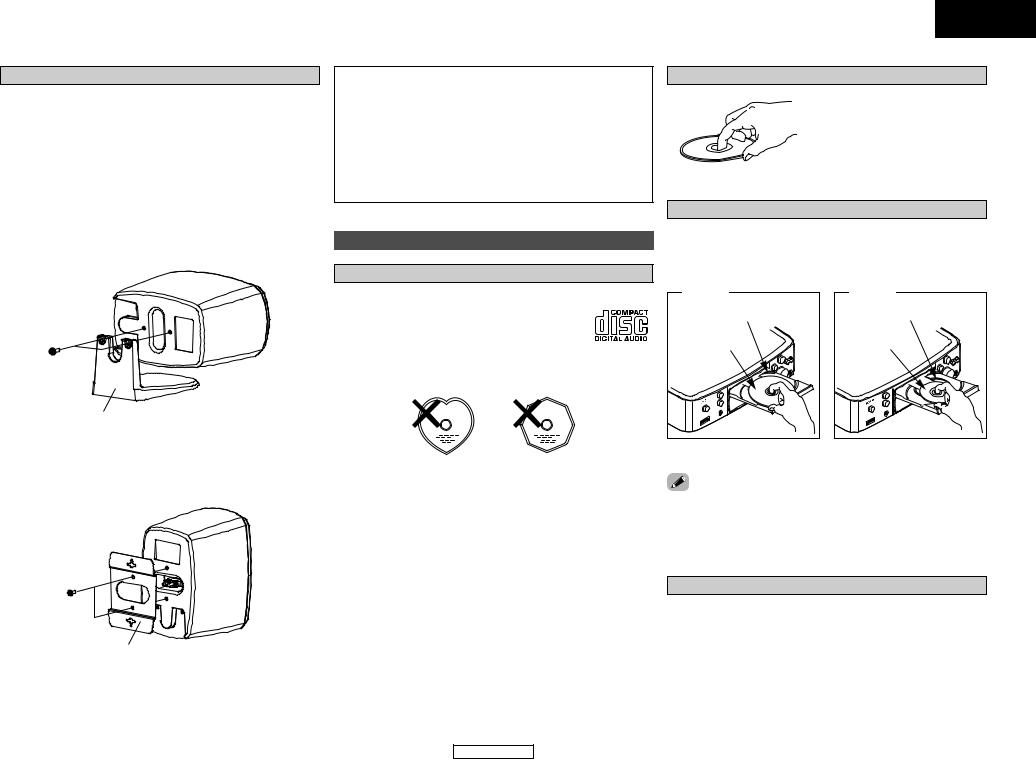
Getting Started
Speaker system (SC-S81)
When installing the speakers, pay attention to the points described below.
•Note that placing the speaker system on the same stand or shelf as a record player may result in howling.
•If a magnet or a piece of furniture or equipment using magnets is placed near the speakers, note that interaction with the S-81 could cause color blotching on the TV.
•The speakers can also be placed sideways.
Set the speaker sideways and fasten the stand securely to the speaker using the two screws that previously fastened the stand. Grasp the two edges of the saran net with your fingers and pull towards you to remove the net, then press on the back of the badge and turn the badge to set it sideways.
SC-S81
Screws
Speaker stand
•The speakers can also be installed using the included wall mount brackets.
Use the four included short screws to securely fasten the wall mount bracket to the mount screw holes on the back of the speaker.
SC-S81
Screws
Wall bracket
CAUTION:
•Mount on a wall sufficiently sturdy to bear the weight of the speaker. Note that DENON will except no responsibility whatsoever for damages or accidents caused by the speaker falling.
•To ensure safety, have a specialist install the speakers on the wall.
•Be sure to fasten the speaker connection cables to the wall, etc., so that you do not get your feet or hands caught in them, causing the set to fall.
About discs
Discs usable on this set
q Music CDs
Discs with the mark at the right can be used on this set.
Note however that discs with special shapes (heart-shaped discs, octagonal discs, etc.) cannot be played. Do not attempt to play them, as doing so could damage the set.
wCD-R/CD-RW
•Some discs and some recording formats may not be playable.
•Non-finalized discs cannot be played.

 Finalization:
Finalization:
Finalization is the process that makes recorded CD-R/CD-RW discs playable on compatible players.
ENGLISH
Getting Started
Holding discs
Do not touch the signal surface.
Loading discs
•Set the disc with the labeled side facing up.
•Make sure the disc tray is fully open when inserting the disc.
•Place the discs flatly, 12 cm discs in the outer tray guide (Figure 1), 8 cm discs in the inner tray guide (Figure 2).
Figure 1 |
Outer tray guide |
12 cm discs |
Figure 2 |
Inner tray guide |
8 cm discs |
• Place 8 cm discs in the inner tray guide without using an adapter.
following cases, “00 Tr 00 : 00” is shown on the display: no disc is loaded
the disc is loaded upside-down
the disc’s information could not be read properly
Cautions on loading discs
•Only load one disc at a time. Loading two or more discs can damage the set or scratch the discs.
•Do not use cracked or warped discs or discs that have been repaired with adhesive, etc.
•Do not use discs on which the sticky part of cellophane tape or labels is exposed or on which there are traces of where labels have been removed. Such discs could get caught inside the player and damage it.
3
ENGLISH
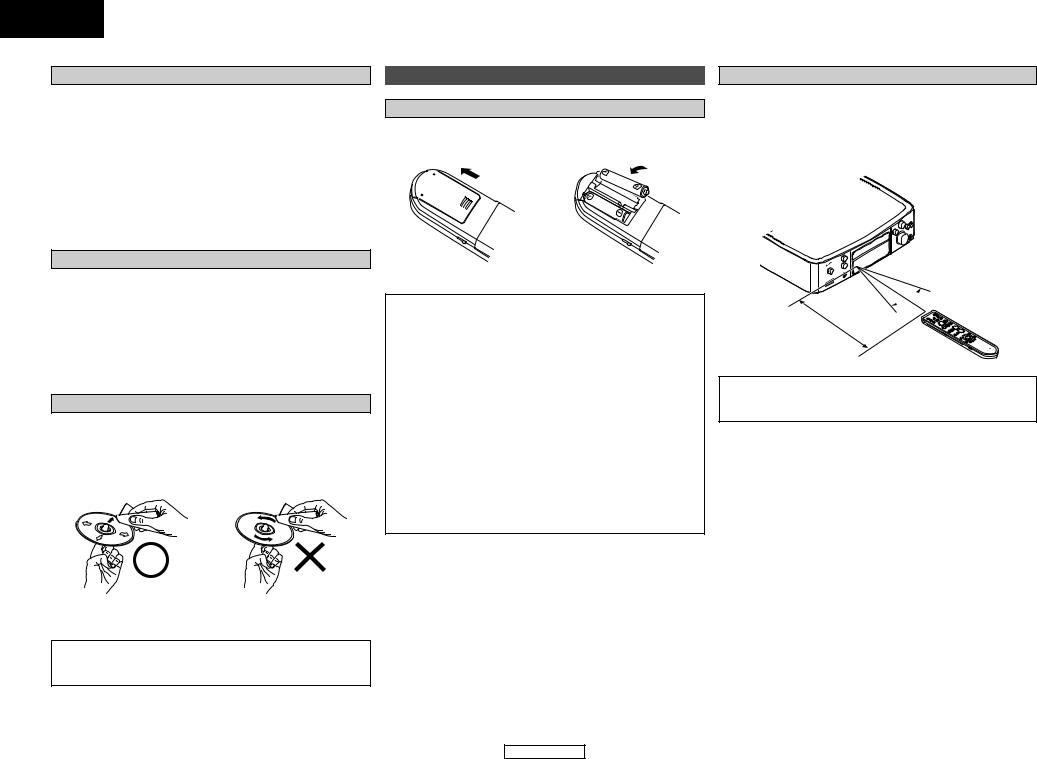
ENGLISH
Getting Started
Cautions on handling
•Do not get fingerprints, oil or dirt on discs.
•Take special care not to scratch discs when removing them from their cases.
•Do not bend or heat discs.
•Do not enlarge the hole at the center.
•Do not write on the labeled (printed) surface with ball-point pens, pencils, etc., or stick new labels on discs.
•Water droplets may form on discs if they are moved suddenly from a cold place (outdoors for example) to a warm place, but do not try to dry them off using a hairdryer, etc.
About the remote control unit
Inserting the batteries
q Remove the remote control |
w Set two R6P/AA batteries in |
unit’s rear cover. |
the battery compartment in |
|
the indicated direction. |
Cautions on storing discs
•Be sure to remove discs after using them.
•Be sure to store discs in their cases to protect them from dust, scratches, warping, etc.
•Do not store discs in the following places:
1.Places exposed to direct sunlight for long periods of time
2.Dusty or humid places
3.Places exposed to heat from heating appliances, etc.
Cleaning discs
•If there are fingerprints or dirt on discs, wipe them off before using the disc. If not the sound quality could be reduced and the sound may be broken.
•Use a commercially available disc cleaning set or a soft cloth to clean discs.
e Put the rear cover back on.
Notes on batteries:
•Replace the batteries with new ones if the set does not operate even when the remote control unit is operated nearby the unit. (The attached batteries are only for verifying operation.)
•When inserting the batteries, be sure to do so in the proper direction, following the “<” and “>” marks in the battery compartment.
•To prevent damage or leakage of battery fluid:
•Do not use a new battery together with an old one.
•Do not use two different types of batteries.
•Do not short-circuit, disassemble, heat or dispose of batteries in flames.
•Remove the batteries from the remote control unit when you do not plan to use it for an extended period of time.
•If the battery fluid should leak, carefully wipe the fluid off the inside of the battery compartment and insert new batteries.
•Remove the batteries from the remote if it will not be in use for long periods.
Getting Started
Operating range of the remote control unit
•Point the remote control unit at the remote sensor when operating it.
•The remote control unit can be used from a distance of up to about 23 feet/7 meters, at a horizontal angle of up to 30° with respect to the sensor.
 30° 30°
30° 30°
Approx. 23 feet/7 m
NOTE:
•It may be difficult to operate the remote control unit if the remote sensor is exposed to direct sunlight or strong artificial light.
Gently wipe the disc from the |
Do not wipe with a circular motion. |
inside towards the outside. |
|
NOTE:
•Do not use record spray, antistatic agents, or benzene, thinner or other solvents.
4
ENGLISH
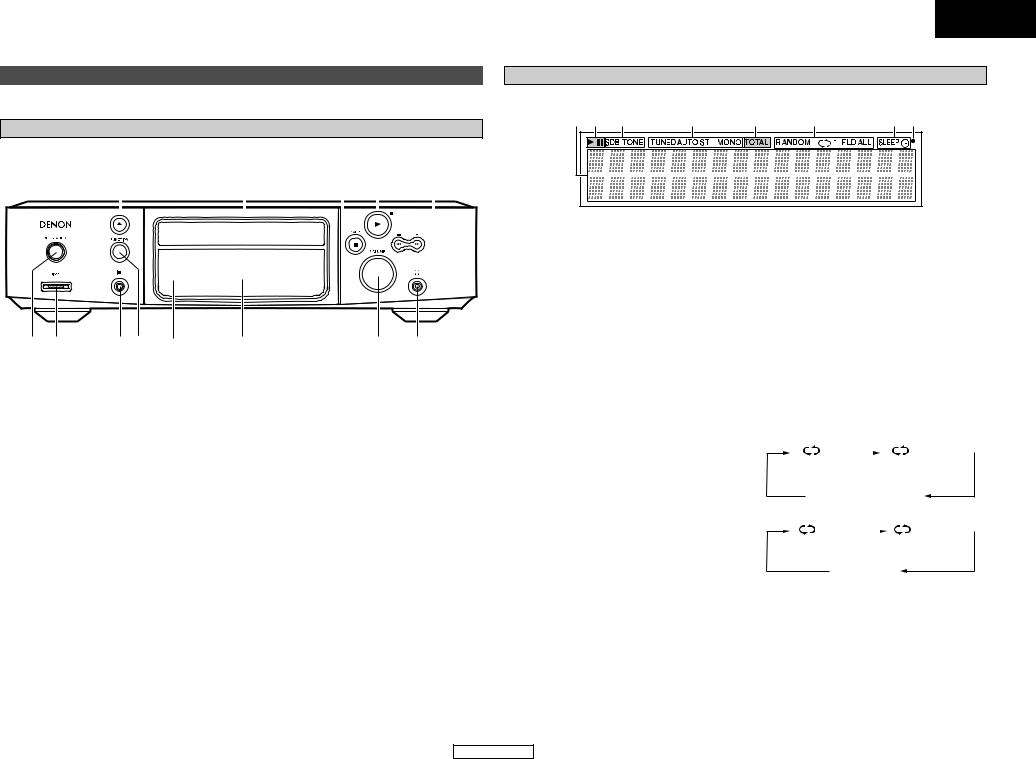
Getting Started
Part names and functions
For buttons not explained here, see the page indicated in parentheses ( ).
Front panel
!3 |
!2 |
!1 !0 o |
||||||||||
|
|
|
|
|
|
|
|
|
|
|
|
|
|
|
|
|
|
|
|
|
|
|
|
|
|
|
|
|
|
|
|
|
|
|
|
|
|
|
|
|
|
|
|
|
|
|
|
|
|
|
|
|
|
|
|
|
|
|
|
|
|
|
|
|
q w |
e r t |
y |
u i |
q Power operation switch
(ON/STANDBY) ·········································(13)
w iPod connector (iPod) ·························(10, 11) e Portable jack··············································(10)
r FUNCTION button·······························(14, 15) t Remote control sensor ·······························(4)
y Display··························································(5)
u VOLUME control knob ·····························(13)
i Headphones jack
Use this jack to connect headphones (commercially available).
When headphones are plugged in, the sound can only be heard from the headphones.
o Skip buttons
(8, 9)················(13, 15, 18 ~ 23, 25, 26) Tuning buttons (+, –) ·································(14)
!0Play/Pause button (1/3) ·························(22)
!1Stop button (2) ·········································(22)
BAND button ····································(14 ~ 17)
!2Disc tray ·······················································(3)
!3Disc tray open/close button (5)··············(13)
ENGLISH
Getting Started
Display
q w e |
r |
w |
t |
y u |
q Information display
Various types of information are displayed here.
•General operational indications:
•Function
•Time
•Volume level
•Tone adjustment level, etc.
•When the function is set to “TUNER”:
•Name of radio station
•Preset station name
•When the function is set to “CD”: [For a music CD/MP3/WMA]
•Total number of folders
•Number of tracks
•Folder number
•Elapsed time
•Track name
•Artist name
•Album name, etc.
w CD play mode indicators
1: Lights when a disc is playing.
3: Lights when the pause mode is set. TOTAL: Lights when the total number of tracks
and total time are displayed at q.
e Tone indicators
SDB: Lights when the super dynamic bass function is set to “ON”.
TONE: Lights when the tone (bass/treble) is being adjusted.
r Tuner reception mode indicators
TUNED: Lights when AM or FM broadcasts are properly tuned in.
AUTO: Lights when in the auto stereo mode. ST: Lights when a stereo broadcast is
received while in the auto stereo mode. MONO: Lights when a monaural broadcast is received while in the auto stereo mode.
t CD/MP3/WMA play mode indicators
RANDOM: Lights when in the random play mode.
 : Lights when in the repeat play mode. The display switches as follows each time the REPEAT button is pressed.
: Lights when in the repeat play mode. The display switches as follows each time the REPEAT button is pressed.
• In modes other than the folder mode:
1 |
|
|
|
ALL |
|
|
|
|
|
|
|||
(1-track repeat) |
|
|
(All-track repeat) |
|
||
Not displayed
• In the folder mode: |
|
|
|
|
|||
|
1 FLD |
|
|
|
FLD |
|
|
|
|
|
|
||||
|
(1-track repeat) |
|
|
(All-track repeat |
|
||
|
|
|
|
|
between folders) |
|
|
|
|
|
|
|
|
|
|
FLD
y Timer operation indicator
 : Lights when the timer is in the standby mode.
: Lights when the timer is in the standby mode.
SLEEP: Lights when the sleep timer is operating.
u Remote control signal reception indicator
Lights when remote control signals are received.
5
ENGLISH
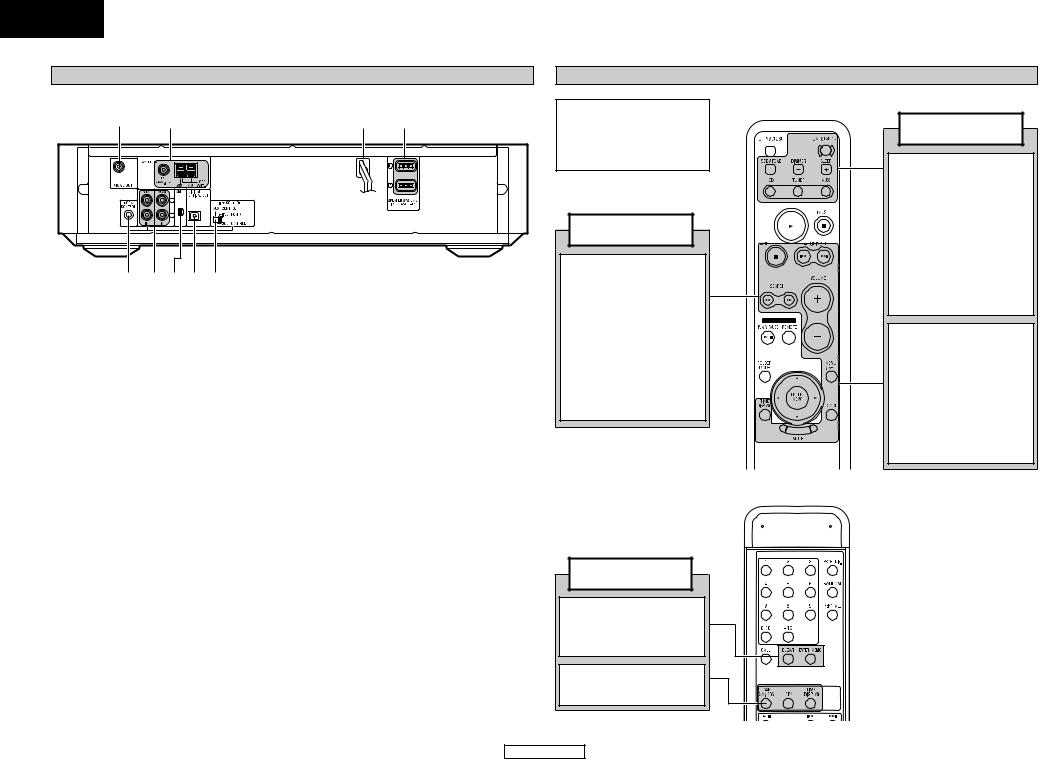
ENGLISH
Getting Started
Rear panel
o |
i |
u |
y |
q w e r t |
q DOCK CONTROL jack································(11)
w Analog input terminals ······················(11, 12) e XM terminal···············································(10)
r DIGITAL OPTICAL OUT terminal ·············(12)
t iPod CONTROL switch ·······················(10, 11)
y SPEAKER SYSTEM terminals ····················(8)
u Power supply cord ····································(12)
i ANTENNA terminals···································(9)
o MONO OUT terminal ··································(8)
6
Getting Started
Remote control unit
NOTE:
•If buttons on the front or rear are pressed strongly, the button on the opposite side will be activated too.
Tuner operating buttons
BAND button
·········································(14)
TUNING button
·········································(14)
SEARCH buttons
(6, 7) ·······················(14)
ENTER/MEMO button
·········································(14)
Cursor buttons
(D, H, G, F)························(14)
TIME/DISPLAY button
·········································(16)
Tuner operating buttons
CLEAR button
·········································(14)
ENTER/MEMO button
·········································(14)
DAB/XM/RDS, PTY TIME/DISPLAY buttons
·········································(16)
[Front]
[Rear]
Amplifier operating
buttons
ON/STANDBY button
·········································(13)
SLEEP button
·········································(20)
Function buttons (CD, TUNER, AUX)
·····························(14, 22, 27)
DIMMER button
Adjusts the brightness of the display.
SDB/TONE button
·········································(13)
Skip buttons
(8, 9) ······················(13)
VOLUME button
·········································(13)
MENU/SET button
···································(18, 21)
CLOCK button
·········································(18)
MUTE button
Mutes the sound.
ENGLISH
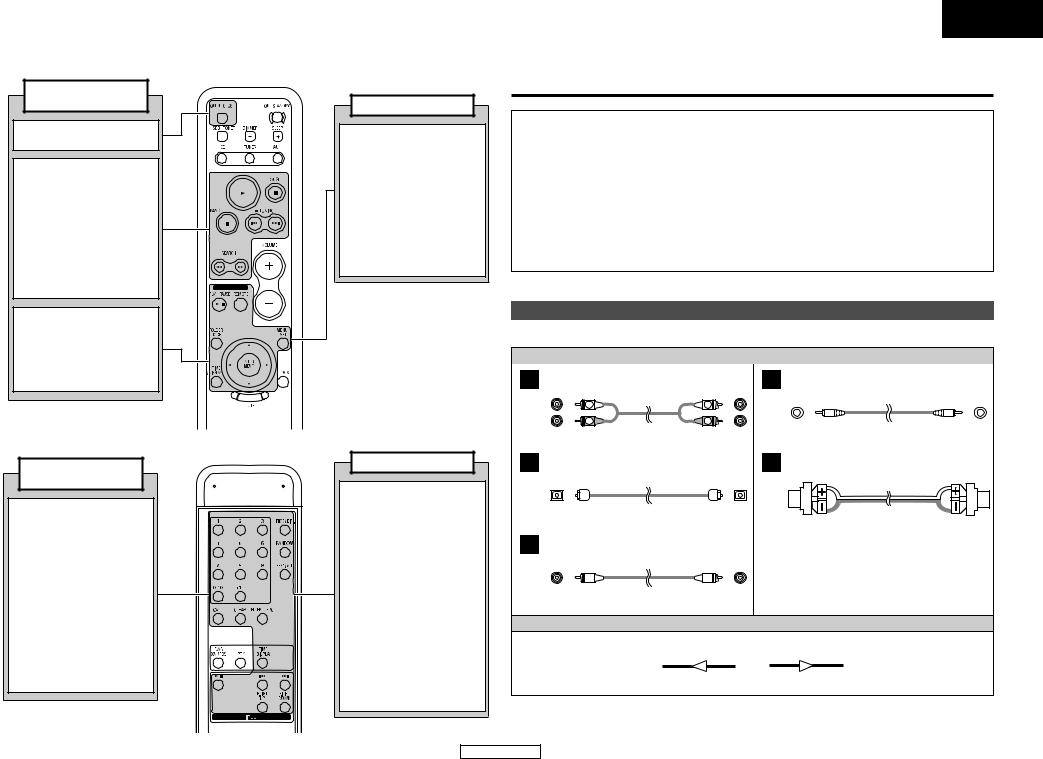
Getting Started
CD player operating buttons
OPEN/CLOSE button
·········································(13)
Play button
(1) ···································(22)
PAUSE button
(3) ····································(22)
Stop button
(2) ····································(22)
Skip buttons
(8, 9) ······················(22)
SEARCH buttons
(6, 7) ·······················(22)
FOLDER MODE button
·········································(25)
TIME/DISPLAY button
·········································(22)
Cursor buttons
(D, H) ································(25)
CD player operating buttons
PROG/DIR. button
·········································(23)
RANDOM button
·········································(23)
Number buttons
(0 ~ 10, +10) ····················(23)
REP 1/ALL button
·········································(23)
CALL button
·········································(23)
CLEAR button
·········································(23)
TIME/DISPLAY button
·········································(26)
[Front]
[Rear] |
iPod controls
iPod REMOTE button
·········································(27)
iPod PLAY/PAUSE button (iPod 1/3)
Play / Pause
MENU/SET button
Menu call
Cursor buttons (D, H)
Cursor movement (up/down)
ENTER/MEMO button
Enter
ENGLISH
Connections
NOTE:
•Do not plug in the power supply cord until all connections have been completed.
•When making connections, also refer to the operating instructions of the other components.
•Be sure to connect the left and right channels properly (left with left, right with right).
•Do not bundle power supply cords together with speaker cables. Doing so could result in humming or noise.
•Making connections with the power turned on could result in noise or damage the speakers.
•Bunching the power supply cords and connection cables together could result in humming or noise.
•Connect all the connection cables between the different components firmly. The system may not operate properly if the connections are incomplete.
•Be sure to disconnect the power supply cords when changing the connections. Changing the connections while the system is operating could result in malfunction.
iPod controls
RANDOM button
Random playback
REP 1/ALL button
Repeat playback
ENTER/MEMO button
Enter
TIME/DISPLAY button
Time/Display switching
iPod PLAY/PAUSE button (iPod 1/3)
Play / Pause
iPod Skip button (8, 9)
Search / Fast-Rewind / Fastforward
iPod P.LIST buttons
Playlist selection
Cable indications
Connect using the connection cables shown below.
Audio cable
A |
Analog connections (Stereo) |
B |
Analog connections (Stereo) |
|
(White) |
L |
L |
|
|
(Red) |
R |
R |
|
|
|
|
|
||
|
|
Pin-plug cable |
|
Stereo mini-plug cable |
C |
Digital connections (Optical) |
D |
Speaker connections |
|
|
|
Optical fiber cable |
|
Speaker cable |
E |
Analog connections (Monaural, for subwoofer) |
|
||
Pin-plug cable
Signal direction
Audio signal
IN |
OUT |
OUT |
IN |
7
ENGLISH
